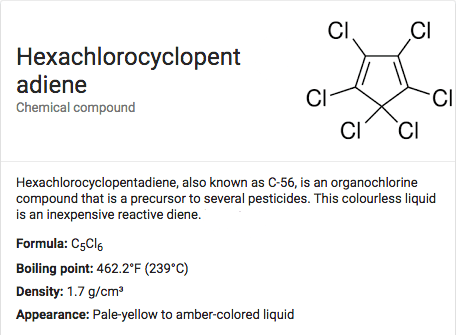About Hexachlorocyclopentadiene (HCCPD)
What is Hexachlorocyclopentadiene?
Also known as C-56, Hexachlorocyclopentadiene is a colorless organochlorine compound and forerunner of many pesticides today. The oily, chemical compound has a pungent odor and may sometimes come in yellow-green organic liquid. The pesticides obtained from the organochlorine compound are known as cyclodienes.
What Types of Industrial Uses Does it Have?
The organic liquid is used as an essential ingredient in the production of other chemicals including pesticides, plastics, flame retardants and many more. Hexachlorocyclopentadiene is manufactured and principally used as an insecticide in the United States and other countries.
How Does Hexachlorocyclopentadiene Get into Your Drinking Water?
Hex can get into water systems through improper discharge from chemical factories. Private wells located near these sites are in danger of contamination.
What are the Health Risks Associated with Hexachlorocyclopentadiene?
Kidney and stomach problems are some of the potential health threats associated with hexachlorocyclopentadiene exposure. If you’re exposed to the contaminated drinking water for a long time, there’s a high chance of experiencing these health issues.
How Common is Hexachlorocyclopentadiene in Water?
The chemical compound is only present in water systems near chemical factories.
What is the EPA’s Standards for Hexachlorocyclopentadiene in Drinking Water?
The maximum contaminant level (MCL) for the contaminant is set at 0.05 mg/L or 50 ppb by the EPA.
What is the Best Reduction Media for Removing Hexachlorocyclopentadiene from Drinking Water?
Water filter systems with granular activated carbon can remove the contaminant from your drinking water to below the EPA’s standard of 0.05 mg/L or 50 ppb. If you’re concerned about your water’s quality or worried about potential contaminants in your feed water, an AquaOx whole house water filter system may save you and your family from hexachlorocyclopentadiene and other chemical compounds. contact us now, and we’ll give you an idea on how we can keep your loved ones safe by improving your water quality.
From The Agency of Toxic Substances and Disease Registry
CAS#: 77-47-4
In summary: HCCPD is a light, lemon-yellow liquid that has a sharp, musty odor. It easily turns from a liquid to a vapor when exposed to air. The vapor looks like a blue haze. This chemical is also called percyclopentadiene, hexachloropentadiene, and hex. Some of its former trade names, still listed in chemical reference documents, are C-56, Graphlox, and HRS 1655.
HCCPD is a manufactured chemical and does not occur naturally in the environment. It is made by adding chlorine to cyclopentadiene, or by removing chlorine from octachlorocyclopentane. HCCPD is used to make a group of related pesticides (aldrin, chlordane, dieldrin, endosulfan, endrin, heptachlor, isodrin, mirex, and pentac). Only two of these pesticides, endosulfan and pentac, are currently registered for use in the United States. Thus, your exposure to these compounds is expected to be limited. Endosulfan and pentac are the only two of these pesticides that you can buy in a store. HCCPD is also used to make flame retardants, resins that won’t burn, shock-proof plastics, esters, ketones, fluorocarbons, and dyes.
Most of the HCCPD in the environment results from releases during its production and disposal. Releases can also occur as a result of the manufacture, use, and disposal of pesticides made from HCCPD. Most people can smell HCCPD in the air at 30 parts HCCPD per billion (ppb) parts of air. Most people can smell it in water when it is present at 1.4 ppb. The amount of HCCPD that you can taste in water has not been measured and the taste has not been described.

-
Water Filters
AquaOx Whole House Water Filter
$3,499.00 – $4,999.00 Select options This product has multiple variants. The options may be chosen on the product pageRated 4.94 out of 5









